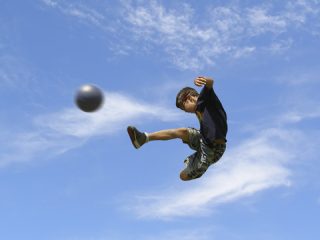Top 3 Footballing Injuries: Number 1 (Ankle Sprains)

Written by Michelle Champlin BSc Pod., M.Ch.S., S.R., Ch., (UK)
With excitement reaching fever pitch for the World Cup today with the final between powerhouses Germany and Argentina, we’ve been asked lots of interesting questions by our football crazy patients, both fans and players alike. We also see an increase in sporting activity when a major tournament is on, whether tennis at Grand Slam time or foot ball during the World Cup. We love people getting out and playing more sport and being active and it’s our job to literally keep people on their feet (and scoring goals!) Our Chief Podiatrist Michelle Champlin shares her insight on the top three most common football related injuries she sees in her clinic, Dubai Podiatry Centre and how you can treat and even prevent these from recurring. Mrs Champlin is a leading sports podiatrist and has been practicing in Dubai for over 14 years and has provided podiatry care to visiting international world-class footballers, local UAE club level footballers and kids playing for their school side. All these players are driven to maximising their potential, know their own bodies extremely well and can spot pain or niggles very early.
We have broken our footballing advice into a three part series (or a game of three halfs?)
Did you know that footballers suffer more injuries than those involved in hockey, basketball, rugby, cricket, badminton, cycling, judo and even boxing? Most football injuries affect the lower body – the groin and pelvis, hip and thigh, knee, calf, foot and ankle. Research shows that most football injuries are caused by trauma, such as a collision with an opponent or landing awkwardly from a jump. Approximately one quarter to one third of all football injuries are due to overuse and develop over a period of time. The majority of injuries occur during competitive matches, as opposed to during training.
According to FIFA, there has been a reduction of around 40% in injuries during this 2014 World Cup compared to previous tournaments. Some of the reasons behind this are believed to be due to decreased contact between players and tougher sanctions against contact leading to injuries. So far, 95 injuries have been recorded, including Brazilian forward Neymar’s broken vertebra and Mexican defender Hector Moreno’s broken leg.
In a statement this weekend, Jiri Dvorak, FIFA’s Chief Medical Officer said: “The medical committee believes there is less contact and fouls, more sanctions for fouls that cause injuries, and continuous improvements by referees from 1990 onwards in terms of education and fair play.”
Unsurprisingly, the most common injuries to affect football players, either professional or amateur, are leg and foot injuries.
Number 1 Football Injury – Ankle Sprains
Ankle Sprains – Sprains to the ankle joint should be treated with extreme care. You will know as soon as you have sprained your ankle, as this tends to happen during trauma in football, frequently caused by a sliding tackle from another player, forcing your foot to roll under. Alternatively, you may land awkwardly when running or jumping for the ball.
Symptoms include swelling (immediate or over the course of several hours), stiffness and reduced range of motion in the ankle, pain when weight bearing.
On the pitch, immediate first aid should be started using PRICE:
P Protect the area from further injury – immobilize by strapping, padding, crutches etc. If a fracture or dislocation is suspected, do not attempt to straighten – immobilize and seek immediate medical attention.
R Rest the area. Do not attempt to be brave and play on as this will lead to worsening the injury and longer time out in the long run.
I Ice the area. DO not apply ice directly to the skin but protect with a cloth or towel. Ice for 15-20 minutes at a time.
C Compression to the ankle with crepe or elastic bandage to help minimize swelling. Do not use adhesive tape – this should only be applied by qualified healthcare professionals such as podiatrists or physiotherapists. Check every few minutes to ensure the bandage is not too tight.
E Elevate the area comfortably by lifting the ankle just above head height to reduce swelling.
What should you do if you suspect an ankle sprain?
All ankle sprains should be assessed by a Podiatrist as sprains can have long term repercussions for lower limb function and alignment. Sprains are treated with the same level of care as a break and a qualified biomechanics sports podiatrist will look at both the cause of the sprain (an unlucky tackle or perhaps an underlying biomechanical anomaly) and provide advice on how to prevent it occurring again. Previous strains increase your likelihood of it happening again. Your Podiatrist may prescribe custom corrective orthotics to correct an underlying foot/ankle alignment issue. If you think you may have sprained your ankle, even if the pain has now subsided, you should see the experts at Dubai Podiatry Centre to check that the injury is fully healed and has not caused any longer term damage. Contact us on 04 3435390.







